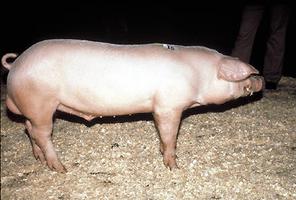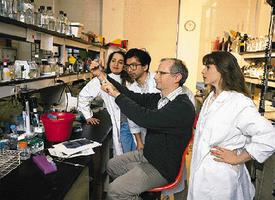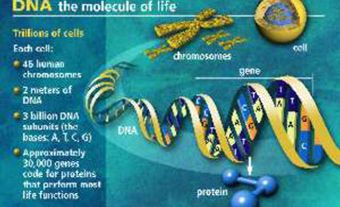Genetics
Genetics is that subdiscipline of biology devoted to the study of heredity, the phenomenon by which organisms pass on their characteristics to their offspring. Although humankind has always shown an interest in heredity, the practice of the science is usually considered to have begun in 1865 with Gregor Mendel, an Austrian monk. Through a study of pea plants, Mendel worked out the simple patterns of inheritance that apply to most inheritable characteristics of living things (eg, size, shape, colour, hairiness, smell, behaviour, disease resistance). Mendel formulated the concept of the gene to define the fundamental units of heredity that determine such properties. Today the molecular structure and function of genes is quite well understood.
Modern Genetics
Genetics may be conveniently divided into 3 areas of study: transmission genetics, molecular genetics and population genetics. Transmission genetics is concerned with identifying the genes that affect a particular characteristic, and also the patterns by which these genes are transmitted from generation to generation, or from cell to cell. Molecular genetics focuses on the structure and function of the genetic units, ie, the chemical composition of genes and their expression in determining the structure of proteins, the most important functional components of cells. Population genetics analyses the pattern of distribution of genes in populations of organisms, and changes in the genetic structure of populations.
Transmission Genetics
The total genetic complement of a cell or organism is called a genome. The particular version of a genome carried by an individual is called the genotype (its set of genes). The outward manifestation of the expression of the genotype is called the phenotype. Individual genes can be identified through phenotypic inheritance patterns, but only if some variation is present in the phenotype. Some phenotypic variation is discontinuous, eg, yellow versus green pea seeds. Discontinuous variation often can be explained genetically by different forms of a gene called alleles: in an example from peas, Y is the allele for the yellow phenotype, and y for green. Plants and animals carry a pair of each gene, so in the pea example, an individual pea can be YY, Yy or yy. Because the Y allele is dominant (written as a capital) the Yy individual is yellow phenotype.
Some phenotypic variation takes the form of a continuous range of values (eg, very short through all intermediate values to very tall). Continuous variation often can be explained by a number of interacting genes (polygenes); the greater the number of genes involved, the greater the possible range of variation. Environmental variation also contributes to continuous variation, so one of the analytical problems in studying such phenotypes is trying to partition continuous variation into genetic variation from environmental variation.
Transmission genetics has found widespread use in traditional agricultural practices, especially in plant and animal breeding. Many plants and animals used in commerce have been developed by breeding procedures. Furthermore, it is now recognized that human health and illness are strongly influenced by genes. Many diseases are known to be genetic in origin, resulting from a mutation to produce a disease-causing allele. Well-known examples of such genetic diseases are phenylketonuria, cystic fibrosis and Tay-Sachs disease (caused by simple Mendelian recessive alleles), Huntington's disease and Marfan syndrome (caused by simple Mendelian dominant alleles) and hemophilia and Duchenne muscular dystrophy (caused by recessive alleles on the X chromosome).
Genetic counselling for such diseases requires risk assessments based on analysis of pedigrees and knowledge of population structure. Another common type of genetic disease is caused by chromosomal abnormalities; for example, Down's syndrome is cause by the presence of an extra chromosome 21. Most cases of Down's syndrome arise anew each generation by chance errors in egg or sperm production.
Molecular Genetics
Genes are organized into structures called chromosomes (humans have 2 sets of 23 chromosomes, each parent contributing a set, for a total of 46). Each chromosome contains a 50 mm length of a threadlike chemical called DNA (deoxyribonucleic acid); however, as each chromosome is less than 0.005 mm long, the DNA must be very efficiently packed through coiling and supercoiling. A gene is simply a functional segment on the thread. It embodies a coded message, in the form of a sequence of chemical units called nucleotides.
The sequence of most genes dictates the sequence of amino acids that make up a specific protein molecule. Proteins are crucial in phenotypic expression because when you look at an organism what you see is either a protein or something that has been made by a protein. Some proteins (called enzymes) control chemical reactions taking place in cells, and some are important structural components of cells, such as microtubules or muscle myofilaments.
DNA has the unique property of being able to make copies of itself (ie, replicate). Bacteria consist of single cells without a membrane-bound nucleus; each cell carries a single circular DNA chromosome that replicates before the cell divides by binary fission, producing daughter cells that are an exact genetic copy of the original cell. Plants, animals and fungi are composed of one or more cells having membrane-bound nuclei. The body cells of plants and animals contain two sets of linear chromosomes per nucleus, and fungal cells one set per nucleus. These chromosomes replicate before body cell division, and the chromosome copies are partitioned equally into daughter cells during an orderly nuclear division process called mitosis.
Plants, animals and fungi also undergo a specialized nuclear division (meiosis) during the sexual cycle. In plants and animals, meiotic division results in sperm and eggs, which contain only one chromosome set per cell. When sperm and egg unite, the resulting cell (the zygote) is the progenitor cell of the body of a new individual, and contains the usual two chromosome sets. During meiosis different allele pairs can assort into new combinations, so zygotes are of many different genotypes, all differing from the two parents. In fungi two nuclei must unite before meiosis can occur, but the cells resulting from meiosis (sexual spores) once again have one chromosome set. Each spore gives rise to a new individual fungus. Because of allelic reassortment, the spore genotypes are different from those of the original fusing nuclei.
Infrequently, DNA undergoes a sequence change, termed a mutation, that alters both genotype and phenotype. This is the ultimate source of all genetic variation. Mutations without obvious cause are referred to as spontaneous mutations; induced mutations result mainly from damage to genes caused by environmental chemicals and radiation.
Mutations are the material on which the environment acts to result in evolution; thus, a mutation that gives an organism an advantage may permit it to produce more offspring which, in turn, contain the mutated gene. Over time, an entire population may change. Of particular concern to human populations is environmental mutagenesis, the development of mutations caused by environmental agents. Increasing levels of chemicals and radiation in the environment may cause mutations in germ cells that over time would result in increased heritable genetic disease, or mutations in body cells resulting in cancer.
A revolution in molecular genetics occurred upon the invention of recombinant DNA technology. This technology allowed genes to be isolated by cloning, characterized in detail by DNA sequencing, and manipulated experimentally in a test tube (in vitro mutagenesis). Improvements of recombinant DNA technology have led to the ability to characterize whole genomes, as for example in the Human Genome Project. Recombinant DNA technology also allows genes to be removed from their original organism and spliced into the chromosomes of other organisms, to create transgenic organisms.
Already such genetic engineering has found application in biotechnology. For example, new strains of bacteria have been developed with major importance in industry, agriculture and medicine (eg, useful in production of human insulin, human growth hormones, interferon for the treatment of viral-induced diseases, and oil- and wood-degrading enzymes). In other approaches, useful novel genes, such as those for herbicide resistance, are being introduced into crop plants, and genes for improved yield or other qualities are being spliced into agricultural animals. Transgenic techniques have also led to the development of human gene therapy, in which a disease-causing genotype can be corrected by the external addition of a normally functioning gene to the genome.
Population Genetics
Different populations of organisms show different frequencies of various alleles. Population genetics attempts to measure these allele frequencies in order to compare the genetic compositions of different populations. The purpose of these measurements can be for ecological studies, or to study evolutionary changes in the population. One fundamental tool is the Hardy-Weinberg formula, which states that under conditions of random mating and with no change of allele frequency, the structure of a very large population can be described as p2 of genotype AA, 2pq of Aa and q2 of aa, where p and q are the frequencies (proportions) of alleles A and a in that population. This will give a stable population structure. The Hardy-Weinberg proportions can be changed by mutation, selection, random changes in allele frequency (genetic drift), and migration, all of which can be considered to be evolutionary forces.
Canadian Genetics
In Canada, research is proceeding in all areas of modern genetics. Most work is taking place at universities and is funded mainly through federal grants. The federal government also sponsors research directly through its own administrative structure (eg, the many research branches of Agriculture Canada). Industry, especially companies producing agricultural or medical products, is becoming increasingly involved in genetics research, especially in molecular technology. Medical genetics studies are undertaken at universities and hospitals. In this discipline, the BC Health Surveillance Registry has compiled a complete record of all birth defects in the province since 1952, a record almost unique in the world. These data permit research into risk estimates for various genetic conditions and of population trends in genetic disease.
Geneticists make a major contribution to Canadian life in a variety of professional situations, eg, as research scientists in university, government or industrial laboratories, and as genetic counsellors in hospitals. Most teaching of genetics courses is done by genetics researchers in universities. The Genetics Society of Canada, headquartered in Ottawa, is the professional association of Canadian geneticists. It holds annual meetings and publishes a journal, Genome, with international distribution.
Professional training for a career as a geneticist or medical geneticist can be obtained in universities or medical schools. At the undergraduate level students obtain a BSc degree in biology, botany, zoology, genetics, microbiology, biochemistry or molecular biology. Graduate studies lead to MSc or PhD degrees. The MSc qualifies an individual for work in a research facility in a subordinate position and to teach; the PhD permits work as an independent genetic researcher in a university department or other research institution. Physicians may take specialized genetics training through the Canadian College of Medical Geneticists (CCMG, Alberta Children's Hospital, Calgary), the world's first such institution. A candidate desiring to pursue a career in clinical genetics (eg, genetic counselling) must pass the examination of the CCMG.
The following Canadian geneticists have been recognized for their exceptional contributions to genetics through the awarding of the Genetics Society of Canada Award of Excellence: Howard B. Newcombe (an early pioneer in the field of mutation), Howard T. Fredeen (animal breeding; development of the Lacombe hog), Len Butler (fundamental genetics of tomatoes), F.Clarke Fraser (mammalian developmental genetics), Clayton O. Person (genetics of host-parasite relationships), R. C. (Jack) von Borstel (mutation in yeast), Bruce Chown (human genetics), Peter B. Moens (cytogenetics of meiosis), Alan P. James (yeast genetics), Etta Kafer (genetics of the mold aspergillus), Michael Smith (site-directed mutagenesis), John Kuspira (wheat genetics and cytogenetics), Lap-Chee Tsui (human genetics; cloning the cystic fibrosis gene), Ford Doolittle (evolution), Charles R. Scriver (human genetic diseases), Robert H. Haynes (mutation), Ken J. Kasha (barley genetics) and Diane W. Cox (human genetic diseases>.
Meet Irene Uchida. A Japanese Canadian scientist, she was one of thousands of Japanese Canadians who were imprisoned as part of the Japanese Internment during WWII. Dr. Uchida went on to become a groundbreaking geneticist, transforming maternal and fetal health around the world.
Note: The Secret Life of Canada is hosted and written by Falen Johnson and Leah Simone Bowen and is a CBC original podcast independent of The Canadian Encyclopedia.
Other notable Canadian contributions are as follows. In 1944 Canadian biochemist Oswald Avery demonstrated that DNA is the hereditary material of the cell, a discovery that made possible the clarification of DNA structure by James Watson and Francis Crick in 1953. The establishment of somatic cell genetics in Canada owes much to Lou Siminovitch. The highly successful marquis wheat was developed early in the 20th century by Charles E. Saunders to withstand the severe prairie climate. Triticale, a new cereal crop, was developed by Leonard H. Shebeski and Edward N. Larter.
The development of canola, ie, improved varieties of rape plants for production of a vegetable oil, was undertaken by research groups headed by R.K. Downey and Baldur Stefansson. David T. Suzuki first achieved recognition for his work on the genetics of the fruit fly (Drosophila melanogaster), and then moved on to a career in science broadcasting. In 1993 Michael Smith won science's highest honour. He shared the Nobel Prize for chemistry with American scientist Kary Mullis. Smith developed the genetic engineering technique of site-directed mutagenesis, a technique for making highly specific changes to gene structure in test tubes.

 Share on Facebook
Share on Facebook Share on X
Share on X Share by Email
Share by Email Share on Google Classroom
Share on Google Classroom




